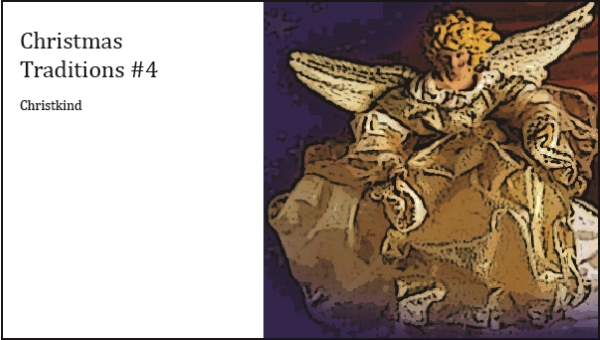By Tyson Thorne

In the first of the Christmas Tradition articles, “Christmas Trees”, we discovered one possible origin of the tradition is Martin Luther. When walking home one Christmas Eve Martin Luther was suddenly struck by the beauty of a grouping of evergreens lightly dusted in snow. In the moonlight they shimmered and glowed with what he believed to be the holiness of the season. Once home Martin chopped down a small fir tree and took it inside to share the experience with his children. As they were celebrating the birth of the light of the world, they decorated the tree with candles. Probably sometime after his inspiration for the Christmas tree Martin Luther, vexed by the attention St. Nicholas was given by the Catholics, invented a story to restore the focus of the season on the Savior. He created Christkind.
German for “Christ-child”, Christkind (or Christkindl) represents the incarnation of Jesus as an infant. Jesus, of course, gave to the world the greatest of gifts to all who would receive it, salvation from eternal separation from God. The Christkind, however, is most often depicted as a sprite-like child with blond hair and an angel’s wings who brings gifts to all the good children of the world. For Protestants, instead of celebrating Saint Nicholas by exchanging gifts on December 6th, they would celebrate the savior by exchanging gifts on December 24th. Children would awaken to presents delivered by the Christkind rather than Saint Nick.
This may appear as a strange tradition to most Americans, but is still largely accepted and practiced the world over. Germany, of course, still holds to the tradition and even has a shopping center called the Christkindlemarkt in Neuremberg. It is also celebrated in Austria, Brazil, Croatia, Czech Republic, France, Hungary, Italy, Liechtenstein, parts of Louisiana, Luxembourg, Poland, Portugal, and Slovakia.
According to the tradition, the children are sent away to play while the parents move presents under the Christmas tree. The children are told that if they try to see the Christkind he will not come at all, guaranteeing their absence. Once the presents are in place the departure of Christkind is announced by the ringing of a small bell. Sometimes the parents pretend to hear it, other times a family member may secretly ring a bell. Either way the children come running in to open their gifts.
Growing up, my family celebrated Christmas in the American tradition. While we knew that Jesus was the central figure of the occasion, Santa Claus always brought gifts on Christmas Eve. My father would go to great lengths to secure my sister and I’s acceptance of the story, to the point of throwing sleigh bells onto our roof making it sound as if Santa’s reindeer had landed. Bells, therefore, played a part in our tradition as well.
However you celebrate Christmas, whether it be Saint Nicholas, ChristKind, Father Christmas, Santa Claus, or non-of-the-above, as long as one remembers the true central figure, Jesus, and the true central gift, salvation, one can hardly go wrong.
Think-Biblically.com wishes all our readers a very Merry Christmas.
|
|
|